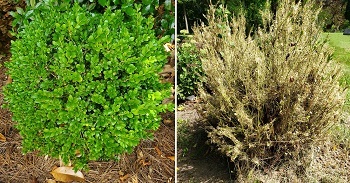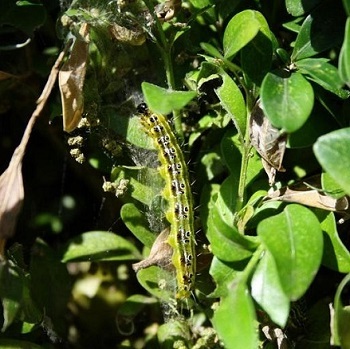|
The following news release was issued earlier today by the Michigan Department of Agriculture and Rural Development.
For immediate release: September 23, 2024
Media contact: Jennifer Holton, 517-284-5724
Program contact: Andria McCubbin, 517-599-5748
Suspected cases can be reported online at Michigan.gov/ReportBTM
LANSING – The Michigan Department of Agriculture and Rural Development is addressing the detection of box tree moth (Cydalima perspectalis) in Lapeer County recently reported by the United States Department of Agriculture. Although this invasive pest is not a threat to Michigan’s natural resources, it can lead to significant defoliation and death of ornamental boxwood.

The new population of box tree moth was discovered through monitoring efforts in collaboration with the USDA. MDARD has been conducting statewide trapping for the pest, while the USDA has focused on trapping around the perimeter of the other 12 counties currently under quarantine to track the spread of this pest.
“These surveying and trapping efforts play a significant role in helping monitor and slow the spread of box tree moth within our state,” said Steve Carlson, MDARD’s Pesticide and Plant Pest Management Division Director. “We’re continuing to work closely with Michigan’s horticulture industry to ensure the safe trade of plant materials and minimize the impact on nurseries, greenhouses, and retailers both inside and outside of the quarantined area.”
|
In 2023, MDARD implemented a box tree moth interior quarantine, which now encompasses 12 counties in Southeastern Michigan: Clinton, Eaton, Ingham, Jackson Lenawee, Livingston, Macomb, Monroe, Oakland, St. Clair, Washtenaw, and Wayne. MDARD is currently working to update the quarantine to include Lapeer County, which would make it the 13th county impacted by BTM.

Box tree moth caterpillars are green and yellow with white, yellow, and black stripes and black spots. Adults have white wings with dark brown borders and a distinctive white dot or mark in the middle of each forewing.
Box tree moth may not be easily recognized at the beginning of an infestation because young caterpillars hide among twigs and leaves. Signs of infestation include chewed, cut, or missing leaves, yellowing or brown leaves, white webbing, and green-black excrement on or around the plant. Larvae skeletonize the leaves and feed on the undersides, causing defoliation and dryness and eventually leading to the plant’s death.
|
If you suspect you have found an infestation and are outside of the quarantine area, please take photographs and report it at Michigan.gov/ReportBTM. After MDARD officials have confirmed a suspected case, residents are advised to remove infested branches or, for heavy infestations, cut the boxwood from its base (it should grow back from its roots). All boxwood debris should be double bagged in plastic and discarded with household trash. Some municipalities or trash vendors may have restrictions surrounding plant material disposal, so please check with your local waste management entity for guidance.
For more information about pest treatment and a list of insecticides known to be effective against destructive caterpillars, view the Michigan State University Insecticide Options for Box Tree Moth Management.
Additional information about box tree moth can be found at Michigan.gov/Invasives.
Michigan's Invasive Species Program is cooperatively implemented by the Department of Environment, Great Lakes, and Energy; the Department of Natural Resources; and the Department of Agriculture and Rural Development.
Note to editors: Accompanying photos are available below for download. Caption information follows.
Boxwood comparison: A healthy boxwood (left) compared to a boxwood heavily damaged by box tree moth caterpillars. Photos courtesy of the U.S. Department of Agriculture.
BTM caterpillar: Box tree moth caterpillars are green and yellow with white, yellow and black stripes and black spots. Photo courtesy of Ferenc Lakatos, Soporon University, Bugwood.org.
|